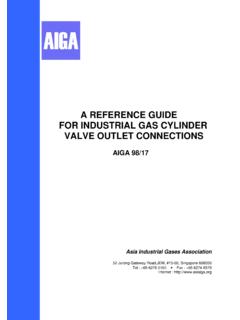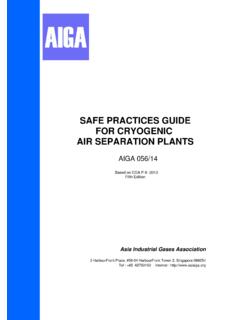Transcription of AIGA 031 13 Bulk liquid oxygen, nitrogen and argon …
1 bulk liquid oxygen , nitrogen AND argon storage SYSTEMS AT production SITES aiga 031 /13 Revision of aiga 031 /06 asia industrial Gases association 3 HarbourFront Place, #09-04 HarbourFront Tower 2, Singapore 099254 Tel : +65 6276 0160 Fax : +65 6274 9379 Internet : Reproduced with permission from European industrial Gases association . All rights reserved. asia industrial GASES association 3 HarbourFront Place, #09-04 HarbourFront Tower 2, Singapore 099254 Tel: +65 62760160 Fax: +65 62749379 Internet.
2 aiga 031 /13 bulk liquid oxygen , nitrogen AND argon storage SYSTEMS AT production SITES Disclaimer All publications of AIGA or bearing AIGA s name contain information, including Codes of Practice, safety procedures and other technical information that were obtained from sources believed by AIGA to be reliable and/ or based on technical information and experience currently available from members of AIGA and others at the date of the publication.
3 As such, we do not make any representation or warranty nor accept any liability as to the accuracy, completeness or correctness of the information contained in these publications. While AIGA recommends that its members refer to or use its publications, such reference to or use thereof by its members or third parties is purely voluntary and not binding. AIGA or its members make no guarantee of the results and assume no liability or responsibility in connection with the reference to or use of information or suggestions contained in AIGA s publications.
4 AIGA has no control whatsoever as regards, performance or non performance, misinterpretation, proper or improper use of any information or suggestions contained in AIGA s publications by any person or entity (including AIGA members) and AIGA expressly disclaims any liability in connection thereto. AIGA s publications are subject to periodic review and users are cautioned to obtain the latest edition. aiga 031 /13 Table of Contents 1 Introduction.
5 1 2 Scope .. 1 3 Definitions .. 2 Terminology .. 2 Freeboard: .. 2 4 General hazards .. 2 Properties of oxygen , nitrogen and argon .. 2 oxygen enrichment or deficiency of the atmosphere .. 2 Ice build-up .. 3 Oil, grease, combustible materials, cleaning and other foreign matter .. 3 Embrittlement of materials .. 3 Cryogenic temperatures .. 3 Perlite .. 4 5 storage tank system design considerations .. 4 General .. 4 Flat bottom tanks .. 4 Description .. 4 Applicable codes and standards.
6 5 Inner tank .. 5 Outer tank .. 6 Annular space purge/pressurising gas .. 6 Piping and 7 Piping stress calculation .. 8 Accumulation of hydrocarbons .. 8 Piping penetration in the outer tank .. 8 Top filling arrangement .. 9 Tank control and protection .. 9 Inner tank pressure/vacuum monitoring and control .. 9 Inner tank overpressure protection devices .. 9 Sizing of pressure relief 10 Inner tank vacuum protection .. 11 Outer tank overpressure protection .. 11 Outer tank vacuum protection.
7 12 Inner tank overfill protection .. 13 Isolation valves .. 14 Emergency shut-off valves .. 14 Foundations .. 15 General .. 15 Base Insulation .. 16 Installation of cellular glass base insulation .. 16 6 storage tank fabrication .. 18 General .. 18 storage and cleanliness of materials at erection site .. 19 Inspection and testing during the fabrication .. 19 7 site selection and layout of installation .. 19 General .. 19 Safety distances .. 20 Location of the installation.
8 20 Outdoor Installation .. 20 Location of underground cable ducts, trenches, drains and open 20 Protection against electrical hazards .. 20 Electrical equipment .. 21 Management of liquid spillage .. 21 aiga 031 /13 Position of gas vents .. 21 Vapour 22 Fire fighting equipment .. 22 liquid transfer area .. 22 8 Testing and commissioning .. 22 Controls during manufacturing and construction .. 22 Testing, pre-commissioning checks and commissioning of installations .. 22 General.
9 22 Tank pressure and leak testing .. 23 Pre commissioning checks .. 23 Commissioning .. 24 9 Operation and maintenance .. 24 Operation of the installation .. 24 Hot work .. 25 Periodic inspection and maintenance .. 25 General .. 25 Tank .. 25 Pressure relief devices .. 26 Level indication and overfill protection .. 26 Emergency isolation valves .. 26 Modifications and change of service .. 26 Change of service .. 26 10 Training and protection of personnel .. 27 Work permit.
10 27 Entry into tanks .. 27 Training of personnel .. 27 Emergency procedures .. 27 11 References .. 28 Annex A - Specific requirements for cluster storage tanks .. 30 Annex B - Specific requirements for vacuum insulated storage tanks (VIT) .. 31 Amendments to aiga 031 /06 Section Change Complete rewrite as a harmonised project aiga 031 /13 1 1 Introduction As a part of a programme of harmonization of industry standards, this publication has been prepared by a group of industry experts representing major industrial gas companies and is based on the technical information and experience currently available to the authors.









